Defrost INFINITI QX60 2018 User Guide
[x] Cancel search | Manufacturer: INFINITI, Model Year: 2018, Model line: QX60, Model: INFINITI QX60 2018Pages: 532, PDF Size: 6.22 MB
Page 248 of 532

NOTE:∙ Odors from inside and outside the vehicle can build up in the air conditioner unit.
Odor can enter the passenger compart-
ment through the vents.
∙ When parking, set the heater and air con- ditioner controls to turn off air recircula-
tion to allow fresh air into the passenger
compartment. This should help reduce
odors inside the vehicle.
AUTOMATIC OPERATION
Cooling and/or dehumidified
heating (AUTO)
This mode may be used all year round as the
system automatically works to keep a con-
stant temperature. Air flow distribution, in-
take air control, and fan speed are also con-
trolled automatically.
1. Press the AUTO button on. (The indica- tor on the button will illuminate and
AUTO will be displayed.)
2. Operate the driver’s side temperature control buttons.
∙ Adjust the temperature display to about 75°F (24°C) for normal operation. ∙ The temperature of the passenger com-
partment will be maintained automati-
cally. Air flow distribution, intake air con-
trol, and fan speed are also controlled
automatically.
∙ A visible mist may be seen coming from the ventilators in hot, humid conditions as
the air is cooled rapidly. This does not
indicate a malfunction.
Dehumidified defrosting or
defogging
1. Press thefront defroster button
on. (The indicator light on the button will
come on.)
2. Operate the temperature control but- tons to set the desired temperature.
∙ To quickly remove ice from the outside of the windows, use the
fan speed
control buttons to set the fan speed to
maximum.
∙ As soon as possible after the windshield is clean, press the AUTO button to return
to the automatic mode. ∙ When the
front defroster button is
pressed, the air conditioner will auto-
matically be turned on at outside tem-
peratures above 36°F (2°C). The air recir-
culate mode automatically turns off,
allowing outside air to be drawn into the
passenger compartment to further im-
prove the defogging performance.
Remote Engine Start with
Intelligent Climate Control (if so
equipped)
Vehicles equipped with automatic climate
controls and Remote Engine Start function
may go into automatic heating or cooling
mode when Remote Engine Start is activated
depending on outside and cabin tempera-
tures. During this period, the climate control
display and buttons will be inoperable until
the ignition switch is turned on. In Remote
Engine Start defrosting mode, the rear win-
dow defroster and heated steering wheel (if
so equipped) may be activated automatically.
Monitor, climate, audio, phone and voice recognition systems4-35
Page 249 of 532

Voice Recognition logic (if so
equipped)
When the climate control system is on, the
front and rear fan speeds may be automati-
cally lowered so that commands are more
easily recognized. Fan speed can be adjusted
using the fan speed decrease and increase
buttons, if desired.
MANUAL OPERATION
Fan speed control
Press thefan speed control buttons to
manually control the fan speed.
Press the AUTO button to return to auto-
matic control of the fan speed.
Temperature control
Press the temperature control buttons up or
down to set the desired temperature.
The temperature can be set within the fol-
lowing range:
∙ For U.S.: 60 to 90ºF (16 to 32ºC)
∙ For Canada: 64 to 90ºF (18 to 32ºC)
Air recirculation
Press theair recirculation button to re-
circulate interior air inside the vehicle.
The
indicator light on the button will
come on.
The air recirculation cannot be activated
when the air conditioner is in the
front
defrosting mode.
When the outside temperature exceeds 70°F
(21°C), the air conditioning system may de-
fault to air recirculation mode automatically
to reduce overall power consumption. To exit
air recirculation mode, deselect the air recir-
culation button (indicator will turn off) to en-
ter fresh air mode.
Automatic intake air control
In the AUTO mode, the intake air will be
controlled automatically. To manually control
the intake air, press the
air recirculation
button. To return to the automatic control
mode, press and hold the
air recircula-
tion button for about 2 seconds. The indica-
tor light will flash twice, and then the intake
air will be controlled automatically.
Air flow control
Press thebutton to manually control
air flow. Pressing the button repeatedly will
cycle through the available modes and dis-
play the corresponding icon on the center
display:
— Air flows from center and side
vents.
— Air flows from center and sidevents and foot outlets.
— Air flows mainly from footoutlets.
— Air flows from defroster andfoot outlets.
To turn system off
Press the OFF button.
CLIMATE button
Press the CLIMATE button on the control
panel to display the screen for front air con-
ditioner operations.
Rear window and outside mirror
defroster switch
For additional information, refer to “Rear
window and outside mirror defroster switch”
in the “Instruments and controls” section of
this manual.
4-36Monitor, climate, audio, phone and voice recognition systems
Page 250 of 532

OPERATING TIPS
The sunload sensor, located on the top driv-
er’s side of the instrument panel, helps the
system maintain a constant temperature. Do
not put anything on or around this sensor.∙ When the climate system is in automatic
operation and the engine coolant tem-
perature and outside air temperature are
low, the air flow outlet may default to
defroster mode for a maximum of 2 min-
utes 30 seconds. This is not a malfunc-
tion. After the engine coolant tempera-
ture warms up, the air flow outlet will
return to foot mode and operation will
continue normally.
∙ When the outside and interior cabin tem- peratures are moderate to high, the in-
take setting may default to turn off air
recirculation to allow fresh air into the
passenger compartment. You may notice
air flow from the foot mode vent outlets
for a maximum of 15 seconds. This is not
a malfunction. After the initial warm air is
expelled, the intake will return to auto-
matic control, air flow outlet will return to
previous settings, and operation will con-
tinue normally. To exit, press any climate
control button.
∙ Keep the moonroof (if so equipped) closed while the air conditioner is in op-
eration. ∙ If you feel that the air flow mode you
have selected and the outlets the air is
coming out do not match, select the
mode.
∙ When you change the air flow mode, you may feel air flow from the feet vents for
just a moment. This is not a malfunction.
LHA2173
Monitor, climate, audio, phone and voice recognition systems4-37
Page 251 of 532
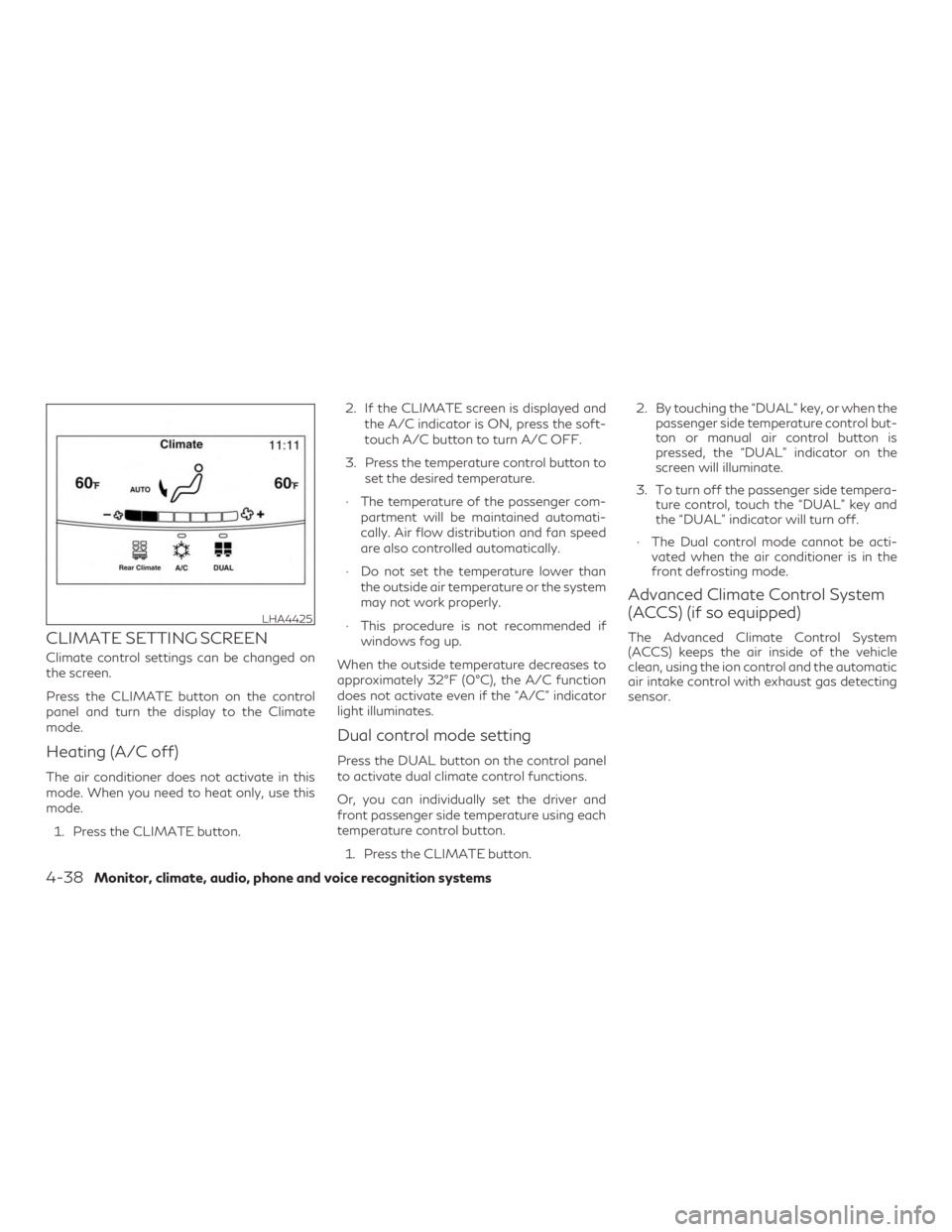
CLIMATE SETTING SCREEN
Climate control settings can be changed on
the screen.
Press the CLIMATE button on the control
panel and turn the display to the Climate
mode.
Heating (A/C off)
The air conditioner does not activate in this
mode. When you need to heat only, use this
mode.1. Press the CLIMATE button. 2. If the CLIMATE screen is displayed and
the A/C indicator is ON, press the soft-
touch A/C button to turn A/C OFF.
3. Press the temperature control button to set the desired temperature.
∙ The temperature of the passenger com- partment will be maintained automati-
cally. Air flow distribution and fan speed
are also controlled automatically.
∙ Do not set the temperature lower than the outside air temperature or the system
may not work properly.
∙ This procedure is not recommended if windows fog up.
When the outside temperature decreases to
approximately 32°F (0°C), the A/C function
does not activate even if the “A/C” indicator
light illuminates.
Dual control mode setting
Press the DUAL button on the control panel
to activate dual climate control functions.
Or, you can individually set the driver and
front passenger side temperature using each
temperature control button. 1. Press the CLIMATE button. 2. By touching the “DUAL” key, or when the
passenger side temperature control but-
ton or manual air control button is
pressed, the “DUAL” indicator on the
screen will illuminate.
3. To turn off the passenger side tempera- ture control, touch the “DUAL” key and
the “DUAL” indicator will turn off.
∙ The Dual control mode cannot be acti- vated when the air conditioner is in the
front defrosting mode.
Advanced Climate Control System
(ACCS) (if so equipped)
The Advanced Climate Control System
(ACCS) keeps the air inside of the vehicle
clean, using the ion control and the automatic
air intake control with exhaust gas detecting
sensor.
LHA4425
4-38Monitor, climate, audio, phone and voice recognition systems
Page 252 of 532
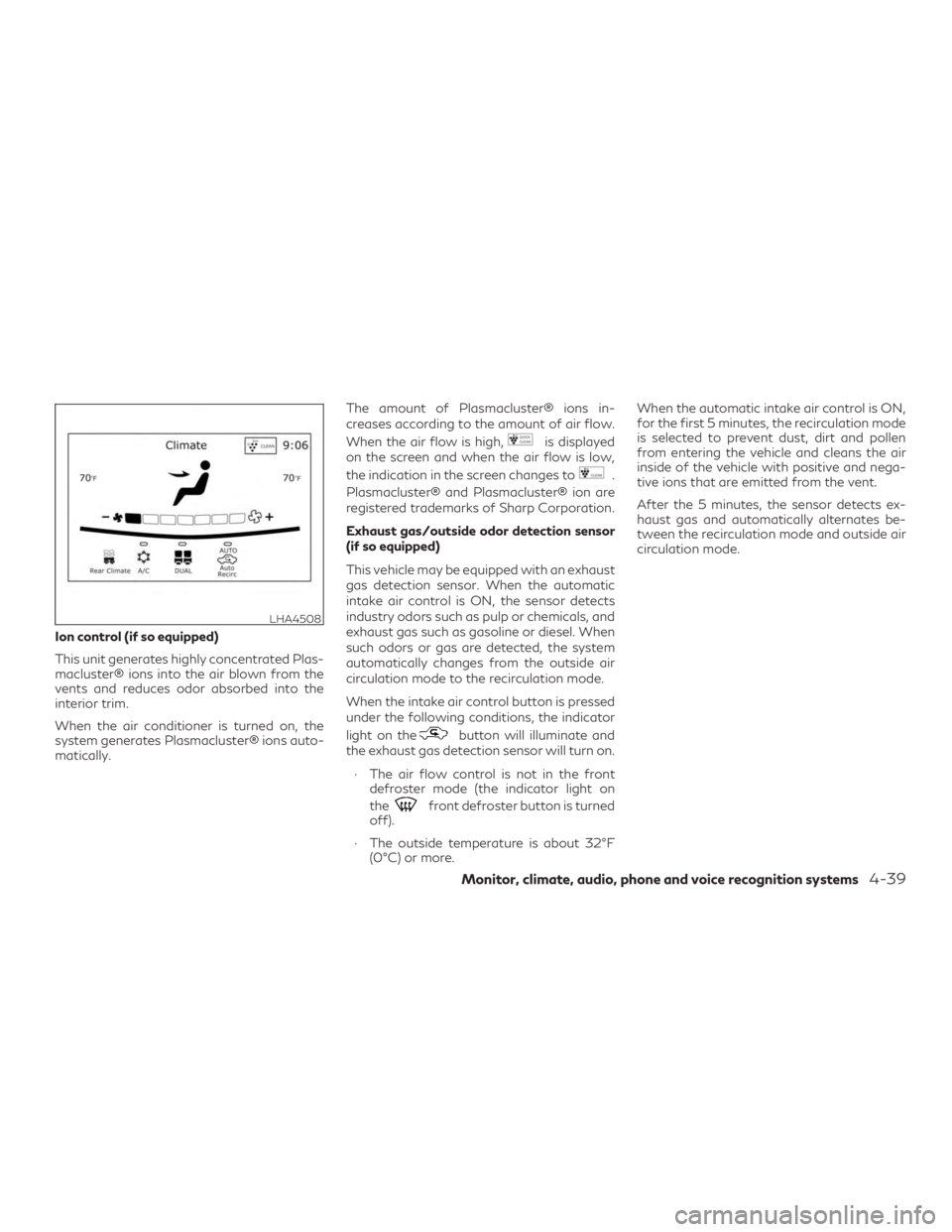
Ion control (if so equipped)
This unit generates highly concentrated Plas-
macluster® ions into the air blown from the
vents and reduces odor absorbed into the
interior trim.
When the air conditioner is turned on, the
system generates Plasmacluster® ions auto-
matically.The amount of Plasmacluster® ions in-
creases according to the amount of air flow.
When the air flow is high,
is displayed
on the screen and when the air flow is low,
the indication in the screen changes to
.
Plasmacluster® and Plasmacluster® ion are
registered trademarks of Sharp Corporation.
Exhaust gas/outside odor detection sensor
(if so equipped)
This vehicle may be equipped with an exhaust
gas detection sensor. When the automatic
intake air control is ON, the sensor detects
industry odors such as pulp or chemicals, and
exhaust gas such as gasoline or diesel. When
such odors or gas are detected, the system
automatically changes from the outside air
circulation mode to the recirculation mode.
When the intake air control button is pressed
under the following conditions, the indicator
light on the
button will illuminate and
the exhaust gas detection sensor will turn on.
∙ The air flow control is not in the front defroster mode (the indicator light on
the
front defroster button is turned
off).
∙ The outside temperature is about 32°F (0°C) or more. When the automatic intake air control is ON,
for the first 5 minutes, the recirculation mode
is selected to prevent dust, dirt and pollen
from entering the vehicle and cleans the air
inside of the vehicle with positive and nega-
tive ions that are emitted from the vent.
After the 5 minutes, the sensor detects ex-
haust gas and automatically alternates be-
tween the recirculation mode and outside air
circulation mode.
LHA4508
Monitor, climate, audio, phone and voice recognition systems4-39
Page 424 of 532
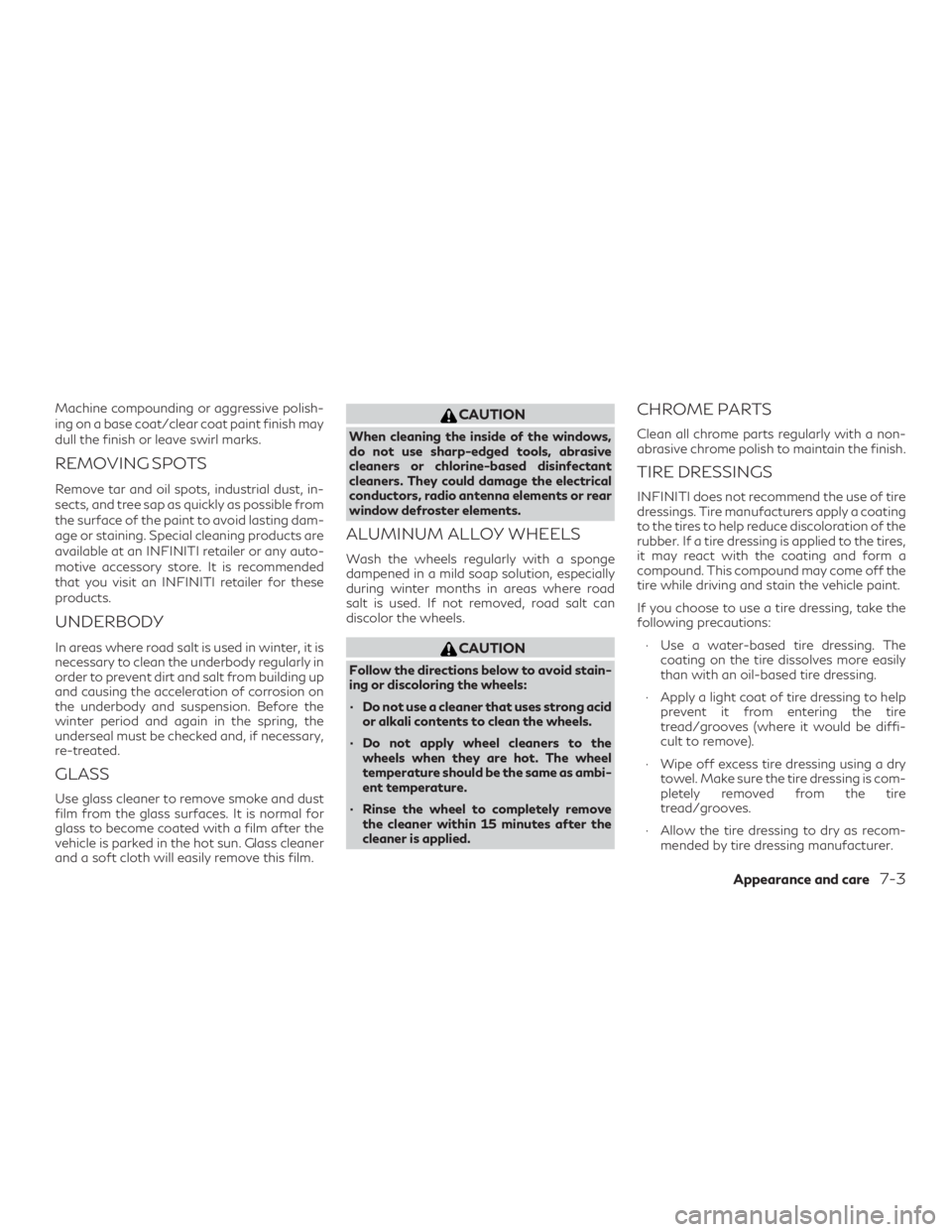
Machine compounding or aggressive polish-
ing on a base coat/clear coat paint finish may
dull the finish or leave swirl marks.
REMOVING SPOTS
Remove tar and oil spots, industrial dust, in-
sects, and tree sap as quickly as possible from
the surface of the paint to avoid lasting dam-
age or staining. Special cleaning products are
available at an INFINITI retailer or any auto-
motive accessory store. It is recommended
that you visit an INFINITI retailer for these
products.
UNDERBODY
In areas where road salt is used in winter, it is
necessary to clean the underbody regularly in
order to prevent dirt and salt from building up
and causing the acceleration of corrosion on
the underbody and suspension. Before the
winter period and again in the spring, the
underseal must be checked and, if necessary,
re-treated.
GLASS
Use glass cleaner to remove smoke and dust
film from the glass surfaces. It is normal for
glass to become coated with a film after the
vehicle is parked in the hot sun. Glass cleaner
and a soft cloth will easily remove this film.
CAUTION
When cleaning the inside of the windows,
do not use sharp-edged tools, abrasive
cleaners or chlorine-based disinfectant
cleaners. They could damage the electrical
conductors, radio antenna elements or rear
window defroster elements.
ALUMINUM ALLOY WHEELS
Wash the wheels regularly with a sponge
dampened in a mild soap solution, especially
during winter months in areas where road
salt is used. If not removed, road salt can
discolor the wheels.
CAUTION
Follow the directions below to avoid stain-
ing or discoloring the wheels:
∙ Do not use a cleaner that uses strong acidor alkali contents to clean the wheels.
∙ Do not apply wheel cleaners to the wheels when they are hot. The wheel
temperature should be the same as ambi-
ent temperature.
∙ Rinse the wheel to completely remove the cleaner within 15 minutes after the
cleaner is applied.
CHROME PARTS
Clean all chrome parts regularly with a non-
abrasive chrome polish to maintain the finish.
TIRE DRESSINGS
INFINITI does not recommend the use of tire
dressings. Tire manufacturers apply a coating
to the tires to help reduce discoloration of the
rubber. If a tire dressing is applied to the tires,
it may react with the coating and form a
compound. This compound may come off the
tire while driving and stain the vehicle paint.
If you choose to use a tire dressing, take the
following precautions:
∙ Use a water-based tire dressing. The coating on the tire dissolves more easily
than with an oil-based tire dressing.
∙ Apply a light coat of tire dressing to help prevent it from entering the tire
tread/grooves (where it would be diffi-
cult to remove).
∙ Wipe off excess tire dressing using a dry towel. Make sure the tire dressing is com-
pletely removed from the tire
tread/grooves.
∙ Allow the tire dressing to dry as recom- mended by tire dressing manufacturer.
Appearance and care7-3
Page 473 of 532
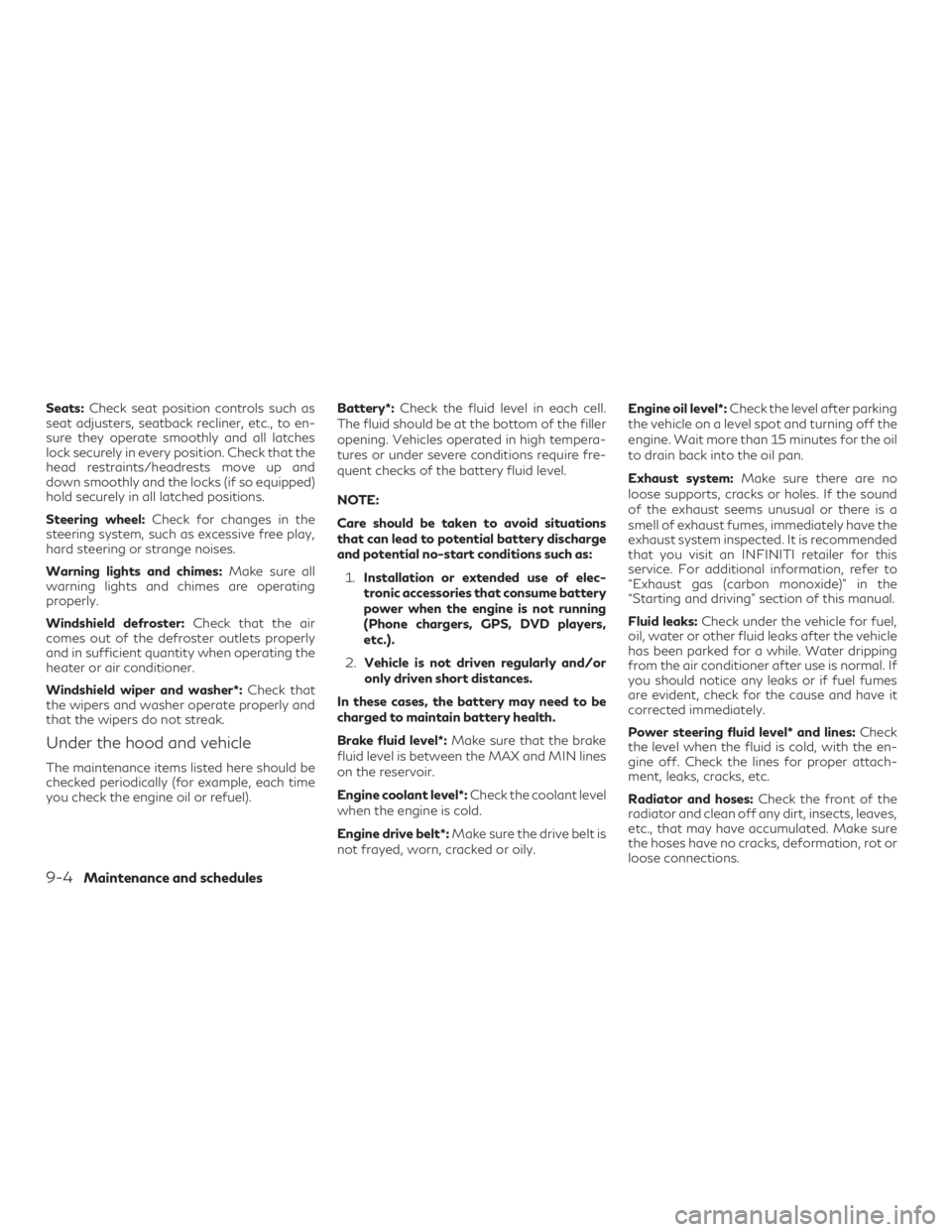
Seats:Check seat position controls such as
seat adjusters, seatback recliner, etc., to en-
sure they operate smoothly and all latches
lock securely in every position. Check that the
head restraints/headrests move up and
down smoothly and the locks (if so equipped)
hold securely in all latched positions.
Steering wheel: Check for changes in the
steering system, such as excessive free play,
hard steering or strange noises.
Warning lights and chimes: Make sure all
warning lights and chimes are operating
properly.
Windshield defroster: Check that the air
comes out of the defroster outlets properly
and in sufficient quantity when operating the
heater or air conditioner.
Windshield wiper and washer*: Check that
the wipers and washer operate properly and
that the wipers do not streak.
Under the hood and vehicle
The maintenance items listed here should be
checked periodically (for example, each time
you check the engine oil or refuel). Battery*:
Check the fluid level in each cell.
The fluid should be at the bottom of the filler
opening. Vehicles operated in high tempera-
tures or under severe conditions require fre-
quent checks of the battery fluid level.
NOTE:
Care should be taken to avoid situations
that can lead to potential battery discharge
and potential no-start conditions such as:
1. Installation or extended use of elec-
tronic accessories that consume battery
power when the engine is not running
(Phone chargers, GPS, DVD players,
etc.).
2. Vehicle is not driven regularly and/or
only driven short distances.
In these cases, the battery may need to be
charged to maintain battery health.
Brake fluid level*: Make sure that the brake
fluid level is between the MAX and MIN lines
on the reservoir.
Engine coolant level*: Check the coolant level
when the engine is cold.
Engine drive belt*: Make sure the drive belt is
not frayed, worn, cracked or oily. Engine oil level*:
Check the level after parking
the vehicle on a level spot and turning off the
engine. Wait more than 15 minutes for the oil
to drain back into the oil pan.
Exhaust system: Make sure there are no
loose supports, cracks or holes. If the sound
of the exhaust seems unusual or there is a
smell of exhaust fumes, immediately have the
exhaust system inspected. It is recommended
that you visit an INFINITI retailer for this
service. For additional information, refer to
“Exhaust gas (carbon monoxide)” in the
“Starting and driving” section of this manual.
Fluid leaks: Check under the vehicle for fuel,
oil, water or other fluid leaks after the vehicle
has been parked for a while. Water dripping
from the air conditioner after use is normal. If
you should notice any leaks or if fuel fumes
are evident, check for the cause and have it
corrected immediately.
Power steering fluid level* and lines: Check
the level when the fluid is cold, with the en-
gine off. Check the lines for proper attach-
ment, leaks, cracks, etc.
Radiator and hoses: Check the front of the
radiator and clean off any dirt, insects, leaves,
etc., that may have accumulated. Make sure
the hoses have no cracks, deformation, rot or
loose connections.
9-4Maintenance and schedules
Page 521 of 532

Child safety rear door lock...........3-6
Chimes, audible reminders ..........2-15
Cleaning exterior and interior ......7-2,7-4
Climate control seat switch .........2-46
C.M.V.S.S. certification label ........10-11
Cold weather driving ............5-144
Console box ..................2-59
Continuously Variable Transmission
(CVT) .......................5-19
Continuously Variable Transmission
(CVT) fluid ..................8-9
Driving with Continuously Variable
Transmission (CVT) ............5-19
Controls Heater and air conditioner controls . . .4-35
Coolant Capacities and recommended
fuel/lubricants...............10-2
Changing engine coolant ..........8-5
Checking engine coolant level .......8-5
Engine coolant temperature gauge ....2-6
Corrosion protection ..............7-7
Cruisecontrol..............5-76,5-77
Cupholders...................2-60
D
Daytime Running Light System .......2-44
Defroster switch Rear window and outside mirror defroster
switch ....................2-39
Dimensionsandweights...........10-9
Dimmer switch for instrument panel ....2-45
Distance Control Assist (DCA) system . . .5-98
Door locks .................3-4,3-5 Drivebelt....................8-15
Drive positioner, Automatic
.....3-39,3-41
Driving Cold weather driving ..........5-144
Driving with Continuously Variable
Transmission (CVT) ............5-19
Precautions when starting and
driving .................5-4,5-11
Driving the vehicle ...............5-19
Dual panel moonroof .............2-68
Dual power moonroof ........2-68,2-68
E
Economy - fuel ................5-130
Emergency engine shutoff .......5-16,6-3
Emission control information label ....10-11
Emission control system warranty ....10-31
Engine Before starting the engine ........5-17
Block heater ................5-145
Capacities and recommended
fuel/lubricants...............10-2
Changing engine coolant ..........8-5
Changing engine oil .............8-7
Changing engine oil filter .........8-8
Checking engine coolant level .......8-5
Checking engine oil level ..........8-6
Engine compartment check locations . .8-3
Engine coolant temperature gauge ....2-6
Engine cooling system ...........8-4
Engine oil ...................8-6
Engine oil and oil filter
recommendation ..............10-6
Engine oil viscosity ............10-6 Engine serial number
..........10-11
Engine specifications ...........10-8
Starting the engine ............5-17
Engine coolant temperature gauge ......2-6
Event Data recorders ............
10-33
Exhaust gas (Carbon monoxide) .......5-4
Explanation of maintenance items ......9-2
Explanation of scheduled maintenance
items........................9-5
Extended storage switch ...........2-56
F
Flashers
(See hazard warning flasher switch) .....6-2
Flat tire ......................6-3
Floor mat positioning aid ............7-5
Fluid Brakefluid .................8-10
Capacities and recommended
fuel/lubricants............... 10-2
Continuously Variable Transmission (CVT)
fluid......................8-9
Engine coolant ................8-4
Engine oil ...................8-6
Power steering fluid ............8-9
Windshield-washerfluid.........8-11
F.M.V.S.S. certification label ........10-11
Fog light switch ................2-46
Forward Emergency Braking (FEB) with
Pedestrian Detection system ....2-10,5-109
Front air bag system
(See supplemental restraint system) ....1-57
Front and rear sonar system ........5-140
Front power seat adjustment .........1-3
11-2
Page 524 of 532

Engine oil and oil filter
recommendation..............10-6
Engine oil viscosity ............10-6
Outside mirrors .................3-37
Overheat If your vehicle overheats .........6-13
Owner's manual order form ........10-34
Owner's manual/service manual order
information..................10-34
P
Parking Parking brake operation .........5-23
Parking/parking on hills .........5-134
Parkingbrake..................5-23
Personal lights .................2-73
Power Power door locks ...........3-5,3-6
Power outlet ............2-54,2-55
Power rear windows ...........2-66
Power steering fluid ............8-9
Power steering system .........5-134
Power windows ..............2-64
Rear power windows ...........2-66
Power inverter switch .............2-53
Power outlet ..............2-54,2-55
Power steering ................5-134
Power steering fluid ..............8-9
Precautions Maintenance precautions .........8-2
On-pavement and off-road driving
precautions..................5-9
Precautions on booster
seats..........1-29,1-36,1-42,1-47 Precautions on child
restraints
.......1-29,1-36,1-42,1-47
Precautionsonseatbeltusage .....1-17
Precautions on supplemental restraint
system ....................1-50
Precautions when starting and
driving .................5-4,5-11
Predictive Forward Collision Warning
(PFCW) ....................5-117
Push starting ..................6-13
R
Radio Car phone or CB radio ..........4-44
Rainsensor...................2-37
Readiness for inspection maintenance (I/M)
test.......................10-32
Rear Cross Traffic Alert (RCTA) .......5-68
Rear Door Alert .........2-31,2-32,2-52
Rear power windows .............2-66
RearView Monitor ...............4-3
Rear window and outside mirror defroster
switch......................2-39
Rear window wiper and washer
switches .....................2-38
Recommended Fluids .............10-2
Recorders Event Data ................10-33
Refrigerant recommendation ........10-7
Registering a vehicle in another
country ....................10-10
Remote Engine Start .........3-20,5-18
Reporting safety defects (US only) ....10-31
Roadside assistance program .........6-2Roof rack
....................2-63
S
Safety Child safety rear door lock .........3-6
Childseatbelts....1-29,1-36, 1-42, 1-47
Reporting safety defects (US only) . .10-31
Seat adjustment Front power seat adjustment .......1-3
Second row bench seats .......1-5,1-8
Seatback pockets ............... 2-57
Seat belt C
hildsafety.................1-26
Infantsandsmallchildren ........1-26
Injured Person ...............1-20
Largerchildren...............1-27
Precautionsonseatbeltusage .....1-17
Pregnant women .............1-20
Seat belt extenders ............1-25
Seat belt maintenance ..........1-25
Seat belts ...............1-17, 7-6
Three-point type with retractor .....1-21
Seat belt extenders ..............1-25
Seat belt warning light ........1-20,2-12
Seats 2nd row bench seat adjustment . . .1-5, 1-8
Adjustment ..................1-2
Armrests ...................1-8
Automatic drive positioner ....3-39,3-41
Front seats ..................1-2
Heatedseats................2-47
Seats/floor mats ..............7-5,7-6
Security indicator light ............2-14
11-5
Page 525 of 532
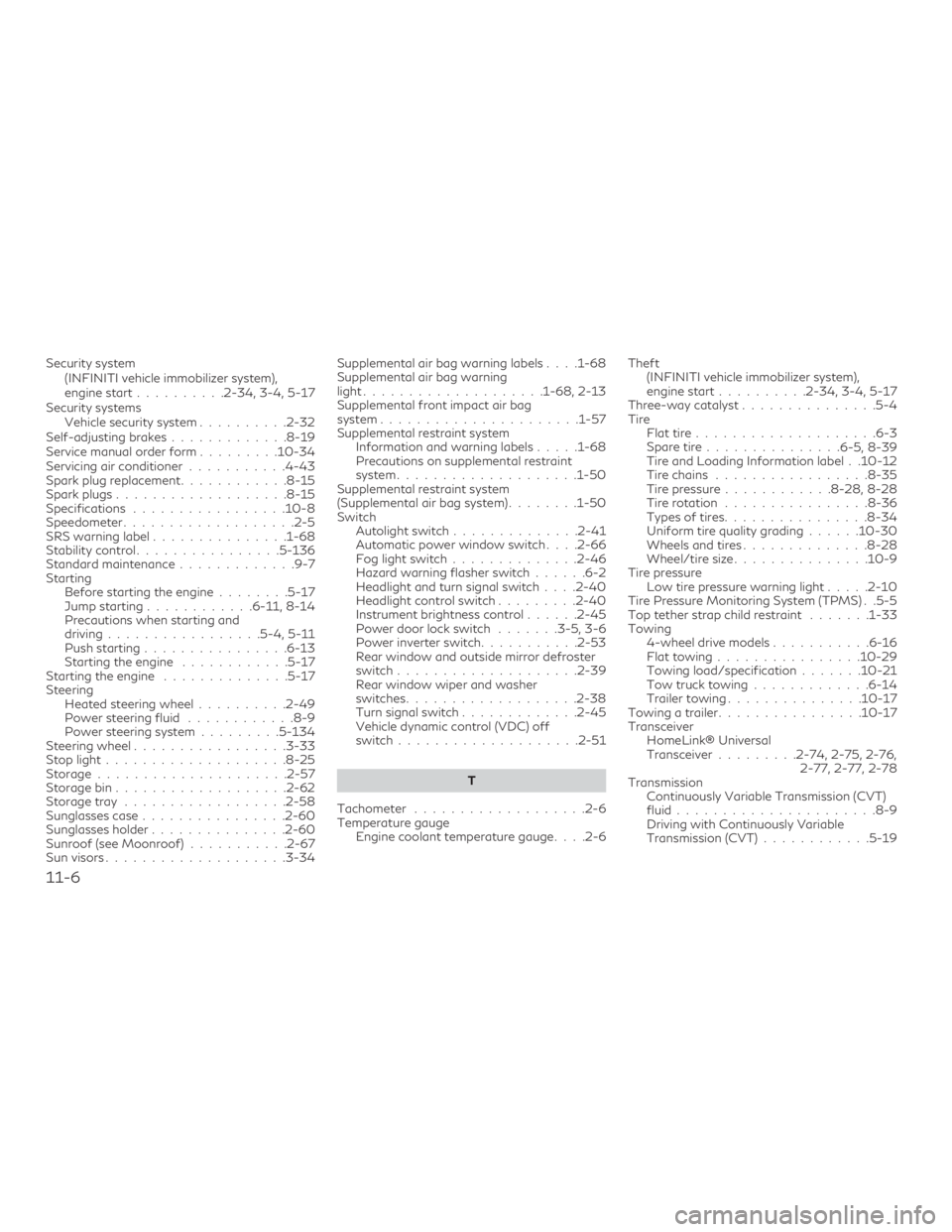
Security system(INFINITI vehicle immobilizer system),
engine start ..........2-34,3-4,5-17
Security systems Vehicle security system ..........2-32
Self-adjusting brakes .............8-19
Service manual order form .........10-34
Servicing air conditioner ...........4-43
Spark plug replacement ............8-15
Spark plugs ...................8-15
Specifications .................10-8
Speedometer ...................2-5
SRS warning label ...............1-68
Stability control ................5-136
Standard maintenance .............9-7
Starting Before starting the engine ........5-17
Jump starting ............6-11,8-14
Precautions when starting and
driving .................5-4,5-11
Push starting ................6-13
Starting the engine ............5-17
Starting the engine ..............5-17
Steering Heated steering wheel ..........2-49
Power steering fluid ............8-9
Power steering system .........5-134
Steering wheel .................3-33
Stoplight....................8-25
Storage.....................2-57
Storagebin...................2-62
Storagetray ..................2-58
Sunglasses case ................2-60
Sunglasses holder ...............2-60
Sunroof (see Moonroof) ...........2-67
Sunvisors....................3-34 Supplemental air bag warning labels
....1-68
Supplemental air bag warning
light....................1-68,2-13
Supplemental front impact air bag
system......................1-57
Supplemental restraint system Informationandwarninglabels.....1-68
Precautions on supplemental restraint
system ....................1-50
Supplemental restraint system
(Supplemental air bag system) ........1-50
Switch Autolight switch ..............2-41
Automatic power window switch ....2-66
Fog light switch ..............2-46
Hazard warning flasher switch ......6-2
Headlight and turn signal switch ....2-40
Headlight control switch .........2-40
Instrument brightness control ......2-45
Power door lock switch .......3-5,3-6
Power inverter switch ...........2-53
Rear window and outside mirror defroster
switch....................2-39
Rear window wiper and washer
switches ...................2-38
Turn signal switch .............2-45
Vehicle dynamic control (VDC) off
switch....................2-51
T
Tachometer ...................2-6
Temperature gauge Engine coolant temperature gauge ....2-6Theft
(INFINITI vehicle immobilizer system),
engine start ..........2-34, 3-4, 5-17
Three-way catalyst ...............5-4
Tire Flat tire ....................6-3
Spare tire ...............
6-5,8-39
Tire and Loading Information label . .10-12
Tire chains .................8-35
Tirepressure............8-28, 8-28
Tirerotation ................8-36
Types of tires ................8-34
Uniform tire quality grading ......10-30
Wheels and tires ..............8-28
Wheel/tire size ...............10-9
Tire pressure Low tire pressure warning light .....2-10
Tire Pressure Monitoring System (TPMS) . .5-5
Top tether strap child restraint .......1-33
Towing 4-wheel drive models ...........6-16
Flattowing................10-29
Towing load/specification .......10-21
Towtrucktowing............. 6-14
Trailertowing...............10-17
Towing a trailer ................10-17
Transceiver HomeLink® Universal
Transceiver.........2-74,2-75,2-76, 2-77, 2-77, 2-78
Transmission Continuously Variable Transmission (CVT)
fluid......................8-9
Driving with Continuously Variable
Transmission (CVT) ............5-19
11-6